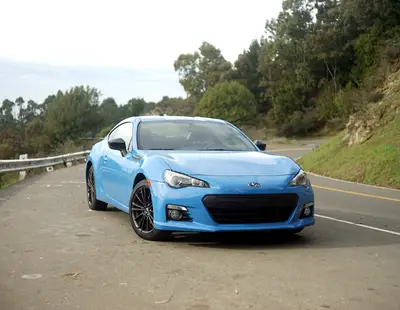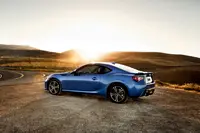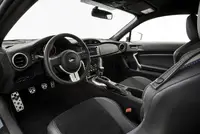2016 Subaru BRZ Series HyperBlue Review by Carey Russ
 2016 Subaru BRZ Series HyperBlue |
The Subaru BRZ is still one of the best-ever affordable sports coupes
DRIVING DOWN THE ROAD WITH CAREY RUSS
• SEE ALSO: Subaru Research and Buyers Guide
 2016 Subaru BRZ Series HyperBlue |
There have been few changes to the Subaru BRZ 2+2 sports coupe since its debut in 2012. Which is a major non-problem. If you get it right, don't mess it up. The BRZ, and its fraternal twin in the North American market, the Scion FR-S, was one of the best affordable and useful sports coupes ever was when it was first released, and its combination of balanced performance, excellent handling, useful space, and good fuel economy means that still holds true.
What's new on the Subaru side for 2016? The standard Starlink™ multimedia infotainment system has been upgraded and a rear-view camera is now standard as well for all examples. Regular Premium and Limited trim levels are joined by a special Series.HyperBlue limited edition, which is basically a Limited with special paint and interior trim. It's any color you want, as long as that's a brilliant light blue reminiscent of the color used on Bugattis in the 1920s and `30s. 500 will be sold, and may already be sold at the time of this writing. Didn't get one? Get a Limited.
Background: Toyota acquired a partial stake in Subaru a few years ago. So what could work as a joint venture? Meaning, what sort of car could be developed using both Subaru and Toyota expertise and parts that could benefit both companies without impinging on existing products? An all-wheel drive sedan might sound logical, but both have existing sedans. And crossovers. So why not something different?
Toyota has made sports coupes before, most recently the front-wheel drive Celica, with the rear-wheel drive Supra and mid-engined MR-2/MR-S more distant memories. Performance at Subaru is spelled "WRX", but there was the Giugiaro-styled SVX coupe back in the early 1990s. Neither currently had a coupe, so there was an opening. Chassis and engine -- horizontally-opposed "boxer" of course -- were largely from Subaru, with Toyota's combination of direct and indirect fuel injection. Styling was primarily from the Toyota side, with more than a passing nod to its rare and exotic 2000GT of the late 1960s. Which itself was a product of a joint venture, with motorcycle maker Yamaha, and meant to show that Toyota could make more than merely appliance-like daily transportation vehicles.
You're unlikely to ever see a 2000GT outside of a museum, as only around 350 were ever built and survivors are worth close to $1,000,000 now. You've likely seen plenty of the Subieota/Toyobaru twins over the past few years, as its combination of affordable performance and the versatility of its 2+2 design have made it a success. The car that comes closest is the Mazda MX-5 Miata, but that's a two-seat convertible. The BRZ is best for two, but can fit two more in back in a pinch ("+2") and/or hold far more in the way of cargo or travel luggage. Which makes it eminently practical as an only car for a driving enthusiast on a budget.
The BRZ is superbly competent on the street or the track, and thoroughly enjoyable to drive. My test car had the stick, which I prefer. But I've also driven automatic examples, on the street, track, and autocross, and little is lost. There have been complaints about "only" 200 horsepower. Only? Note that both horsepower and torque peaks are at relatively high revs -- 7000 and 6400 rpm, respectively -- and let it sing and you'll go a lot quicker. But it's fine driven more sedately and I got 28 mpg for the week, more than a bit of a surprise although I did see 29 from an automatic FR-S. Wonderful handling, all of the expected amenities, a useful interior, and little thirst -- what more could you want from a real-world sports car?
APPEARANCE: No changes, no changes needed. How to differentiate the Subaru BRZ from a Scion FR-S? Metal body panels are shared, as are lights. At the front, bumper fascias are different. The grille shape is similar, but the BRZ's is widest at the top, with an inset bumper bar, while the FR-S's is widest at the bottom. The BRZ has wider, shorter faux brake ducts around its foglamps. It has a simulated air duct on each front fender; the FR-S has its opposed-piston/86 badges. At the rear, the only difference is badging. Either way, it looks like a proper 2+2 sports coupe, and only the use of modern bumper technology (a good thing) shows it to be contemporary rather than an exotic from the 1960s. The proportions are timeless. The Series.HyperBlue edition has bright blue paint and black mirrors.
 2016 Subaru BRZ Series HyperBlue |
COMFORT: The twins are more different inside than out, and the interior design is discernibly Subaru. The BRZ is targeted at a slightly older buyer than the FR-S, so it's a bit more conservative, with less of a race-car look. The Series.HyperBlue cars get blue stitching and embroidered badging. There is no glare from the textured, soft-touch instrument panel top. Appropriately, the tachometer gets prime real estate, with the analog speedometer tucked away to the lower left. That's not a problem, as a digital speed display is set into the tach. The steering wheel is all business, with no control buttons. "Connectivity" here is primarily with the road, although the Starlink system does include all current audio choices and Bluetooth connectivity.
The steering wheel is manually-adjustable for tilt and reach, and the driver's seat has cushion height adjustment, so all drivers can find their perfect driving position. Seats here have grippy Alcantara cushions and backs, with leather used for the bolsters. Adjustment is manual and the front seats have heated cushions. In sports car terminology, "+2" means there are rear seats, but don't expect the room and amenities of a sedan. Five foot six is about the maximum back there, and only if front passengers are about the same size. The rear seatback folds in one piece for extra luggage capacity. The BRZ is not a hatchback, so structurally good and rigid, but access through the trunk lid can be tight. A space-saver spare tire and jack live under the cargo compartment floor.
SAFETY: Excellent four-wheel vented disc brakes with electronic brake force distribution and brake assist, traction control and vehicle stability control and precise steering and cornering ability are safety features as much as performance features. The BRZ's unibody structure is designed for passenger protection, and frontal, front side, and side curtain airbags are standard equipment.
RIDE AND HANDLING: The first drive I had in a BRZ was on a damp race track, at an automotive journalists' association track day. The BRZ was not the quickest or fastest car. It may not even have had the highest cornering limits. For me, it was by far the most fun to drive. On the track, limits are high, it's stable at speed and immediately responds to driver inputs from both the steering wheel and right foot. The rear end can be kicked out in a controlled manner -- not a good idea on the street -- but in case of a quick need for an emergency maneuver, an obstacle is more likely to be avoided by driving around it. I later had more experience in the FR-S version on a dry track and autocross course. Also great, and a natural-born autocrosser. Anyone who believes that electrically-assisted power steering has to be numb and without feedback needs to drive this car. There is just the right amount of road feel through the steering wheel.
Good track cars often make poor road cars as the suspension setup that limits weight transfer from body yaw, pitch, and roll can be uncomfortably stiff once the adrenaline and endorphins wear off. No problem here. Yes, the BRZ's MacPherson strut/double wishbone suspension is (appropriately) firm, but not uncomfortably so. Interior noise levels are surprisingly low. A long day in the driver's seat is a pleasure.
PERFORMANCE: Complaints about the BRZ's performance center around a perceived lack of power. 200 horsepower from a 2.0-liter naturally-aspirated engine is now considered low? A 6.5-second 0-60 time is not quick enough? Someone's pretty spoiled…
The engine, being Subaru, is horizontally-opposed, with four cylinders. It's low and short, and mounted well back in the chassis for optimum weight distribution. Its low height means a low center of gravity, for less weight transfer when cornering and consequent improvement in adhesion and handling characteristics. Dual overhead camshafts, with variable cam phasing on all, and a combination of direct and port fuel injection, plus a high 12.5:1 compression allow it to make efficient power. That 200 hp is developed at a high 7000 rpm. Torque peaks at 151 lb-ft at 6400 rpm. Yes, it likes to rev, and short-shifting (or the automatic in D) will miss the power entirely. There is enough torque down low for easy drivability and good fuel economy in everyday driving, but it really comes alive over 4500 rpm. Shifting the manual gearbox is quick and smooth, and a pleasure. A standard Torsen limited-slip differential ensures that power gets to the ground efficiently. EPA fuel economy is listed as 22 mpg city, 30 highway. With mostly wet weather putting a damper on too much enthusiasm and mostly just regular driving, in city traffic and on highways, I got 28 miles per gallon for the week. Serious regular acquaintance with the upper part of the rev band would see that dramatically decrease -- but it's there when you need or want it.
CONCLUSIONS: The Subaru BRZ is still one of the best-ever affordable sports coupes for its winning combination of road manners, performance, economy, and usefulness.
SPECIFICATIONS
2016 Subaru BRZ Series.HyperBlue
Base Price $ 27,690
Price As Tested $ 28,485
Engine Type aluminum DOHC 16-valve horizontally- opposed 4-cylinder with direct and port fuel injection and variable cam phasing
Engine Size 2.0 liters / 122 cu. in.
Horsepower 200 @ 7000 rpm
Torque (lb-ft) 151 @ 6400 rpm
Transmission 6-speed manual
Wheelbase / Length 101.2 in. / 166.7 in.
Curb Weight 2784 lbs.
Pounds Per Horsepower 13.9
Fuel Capacity 13.2 gal.
Fuel Requirement 91 octane premium gasoline
Tires 215/45R17 87W Michelin Primacy HP
Brakes, front/rear vented disc all around, ABS, EBD, BA standard
Suspension, front/rear independent MacPherson strut / independent double wishbone
Drivetrain front engine, rear-wheel drive
PERFORMANCE
EPA Fuel Economy - miles per gallon city / highway / observed 22 / 30 / 28
0 to 60 mph 6.5 sec
OPTIONS AND CHARGES
Destination Charge $ 795


